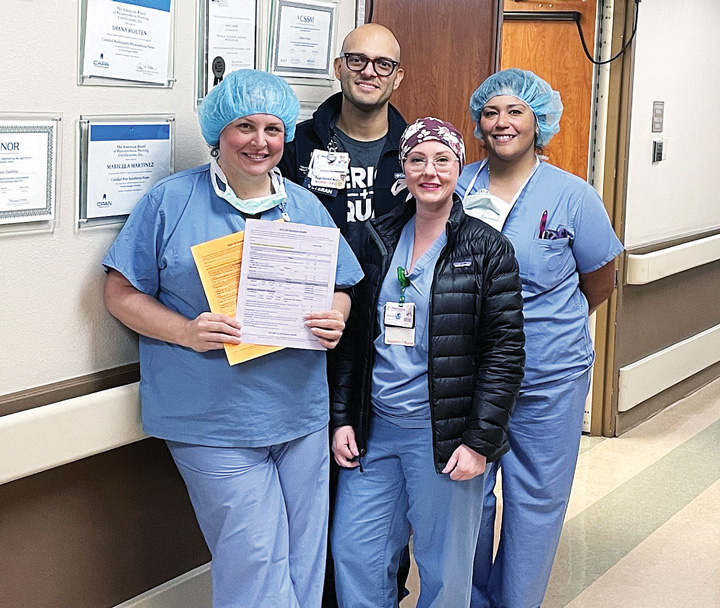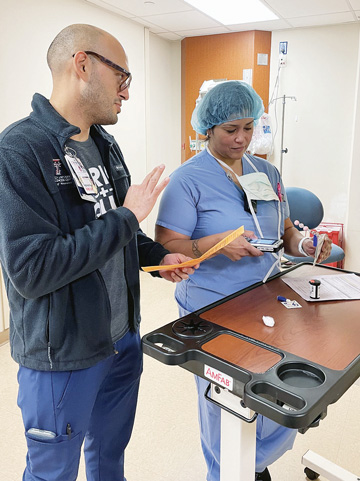CRNAs Focus on Staff Wellness and Patient Safety
The American Association of Nurse Anesthesiology (AANA) has joined the ALL IN: Wellbeing First for Healthcare coalition, saying the group’s initiative to improve the...
This website uses cookies. to enhance your browsing experience, serve personalized ads or content, and analyze our traffic. By clicking “Accept & Close”, you consent to our use of cookies. Read our Privacy Policy to learn more.
By: Nicole Miljak, MSN, MBA, RN, CNOR and Jesus Martinez, BSN, RN, EMT-P
Published: 4/24/2024
We know that a zero-tolerance approach for surgical sight infections (SSIs) is what keeps our patients safe, but we also understand that even the slightest change in our prevention practices or patients’ health can increase our SSI rates.
That’s why, when our teams saw an uptick in SSIs in 2022, we explored our best approach for a strategic-but-swift response to investigate where we could adjust our SSI prevention practices. Our journey was well worth the time and effort, as we achieved a 44% reduction in SSIs for colon surgeries.
But even one SSI is one too many. We continue our journey to smash SSIs and move closer toward the ultimate goal of zero infections. We hope other teams can learn from our work and find their own wins to protect patients from surgical site infections.
In 2022, our CNO launched an improvement initiative involving clinical scene investigator groups in departments across the hospital. This work created opportunities to advance patient safety. In the perioperative department, we realized our opportunity to help our patients centered around investigating an uptick in SSIs.
We gathered an initial team of nurses to begin our investigation. While an existing process was in place for SSI prevention — including a colon SSI reduction bundle — it wasn’t a solid process. We needed to build more standardization and accountability into our practices, and this required increased education and collaboration. Two years into our process, we have not one, but two very effective SSI bundles, including an improved one for colon surgery and a new SSI bundle for open and robotic hysterectomy procedures. Our SSI rate for colon surgeries is down 44% (from nine SSIs to five). This significant decline represents a win for patient safety, and it also represents major cost savings. Eliminating four SSIs in just one year saved our facility more than $200,000. The changes we made to our bundles cost us nothing, and we now spend minimal time auditing our SSI bundles in practice. Here are some of the steps we’ve found helpful in our journey to smash SSIs.
• Scrutinize your SSI data. After crystalizing our initial vision for an SSI investigation, we collaborated with our infection preventionists to evaluate our 2022-2023 data and analyze SSI trends. This partnership has been essential because infection preventionists can share the data and resources to not only help us understand infection trends but also align our mission toward zero SSIs with physician partners and other key stakeholders. Based on our data analysis, we identified SSI increases were primarily in colorectal surgery and to a lesser extent in hysterectomy procedures.
• Review your patient health against the literature. Every hospital’s patient population is unique. In our region, many patients who need colorectal and hysterectomy procedures face uncontrolled diabetes and other comorbidities that increase their SSI risk. We considered how small-but-meaningful changes such as monitoring these patients’ glucose levels in pre-, intra- and postoperative phases of care and refining our antibiotic approaches could be beneficial. There was far more literature on patient health tied to our SSI bundle for colon surgery, and this helped us determine how to address things such as glucose monitoring differently in our bundles. We found far less data on SSI prevention practices for patients undergoing hysterectomies. Collaboration with our OB/GYN physicians helped us create and refine our hysterectomy bundle.
• Take a fresh look at your bundles. Our previous SSI bundle for colon surgeries was largely structured from the Duke University Health System bundle that’s used in many surgery centers. Many key elements remained the same, but we standardized some things to meet the needs of our patient population. For example, we revised our prophylactic antibiotic and dosing to reduce the chance for delayed doses and addressed re-dosing in the event of significant blood loss (more than 1500 mL).

We also changed how our SSI bundles are applied. We structured them with step-by-step questions to document, in writing and electronically, tasks such as confirming CHG bath before surgery, antibiotic timing, hair clipping and bowel prep in the colon surgery SSI bundle.
Our hysterectomy bundle was created from scratch through this project, and required more iterations and more collaboration with physicians to dial in practices and secure buy-in. The major hurdle was tied to our recommendation that the surgeon change gloves after cuff closure and before closing the fascia, similar to recommendations in our colon bundle. However, we have both open and robotic hysterectomies at our facility, and the bundle needed to be reviewed more carefully as a team to discuss the evidence and make sure practices could be standardized for all hysterectomy procedures.
• Integrate your bundle into your electronic health record (EHR). You know the saying, “If you didn’t document it, it didn’t happen”? We reiterated this statement a lot in our education to help team members understand how important it is to follow the bundle and document every element covered, both in our paper audit form and in the patient’s EHR. These data are critical for our ongoing auditing work, to refine the bundle process and for analysis as we continue to monitor for SSIs. Clear documentation on bundle actions made it very convenient to review our data and discuss audits with team members to help sustain compliance.
• Refine, test and refine again. We kicked off our SSI bundles on Feb. 8, 2023. Five days later we suspended the hysterectomy bundle because we had major pushback from physicians. We jumped right in to address these barriers by holding a series of meetings with our OB/GYN surgeons and infection prevention colleagues to work through challenges. In the end, this conversation and a shared understanding of risk-reducing actions — namely, when to change gloves and how to reduce infection risks during closure — led to agreement about the elements of the bundle in question. These SSI-reduction practices have been adopted with full approval and are in practice today. The colon reduction SSI bundle was adopted with virtually no objections.
• Listen to your frontline. Buy-in is key for any change in perioperative practice and that has certainly been true with our SSI bundle work. Education helped us reiterate the rationale behind practice changes, but it’s been equally important for us to ask for input and then listen to the feedback. It took five additional months to get our hysterectomy SSI bundle relaunched. We tweaked practices, but we also spent this time discussing best practices together, and this was time well spent for everyone. We’ve learned the value of visibility with bundle elements. For example, our colon SSI bundle included widespread practices that garnered no hesitation from surgeons because most of the steps were already in place — we just needed structure around the elements to ensure standardization. In contrast, the hysterectomy SSI bundle was so new that it required more time to capture buy-in and tweak for optimized use. Seeking our OB/GYN physicians’ input as the experts and then patiently waiting for their responses was the turning point in creating the hysterectomy SSI bundle we now use.
We also worked with our pharmacy and formulary to include cefotetan as an antibiotic option for longer surgeries because it requires only one dose every six hours and reduces the need for antibiotic redosing in many procedures. This has been a game changer in preventing delayed antibiotic dosing that can open the door to infection.

With our hysterectomy SSI bundle and colon surgery SSI bundle both digitized in our EHR, we can easily audit the documented data. We also round to observe each bundle in practice whenever either procedure happens. We average around 20 to 30 cases per day and have approximately nine colon surgeries and five hysterectomies per week.
In addition to a 44% reduction in colorectal surgery SSIs in 2023, our 2024 numbers show zero SSIs for colon cases. Our hysterectomy SSIs initially rose by one during the initial bundle launch (two in 2022 to three in 2023). However, we have had no SSIs in our hysterectomy surgeries in 2024 so far, which tells us the SSI bundle is working.
When our team looks back on these successes, we talk about the many lessons we learned along the way. Most important: Partnering with physicians and seeking their input before implementing a bundle is essential. We also learned the power of accountability and awareness of best practices. Nothing we did was revolutionary. It’s been more of a back-to-basics approach that ensures quality practices are performed consistently. Many unofficial leaders emerged through this project, including nurses. The SSI bundles provide tools to empower everyone on our team to speak up for safe surgery. Our ultimate goal is to promote zero harm in everything we do. This starts with leading by example and proving that patient safety is our number one goal. OSM
The American Association of Nurse Anesthesiology (AANA) has joined the ALL IN: Wellbeing First for Healthcare coalition, saying the group’s initiative to improve the...
Once you understand that being a perfectionist can be harmful to your personal outlook, health and anxiety level, you can unravel what to do about it....
The start of the year is a great time to clear the decks mentally and review for yourself what works and what does not....